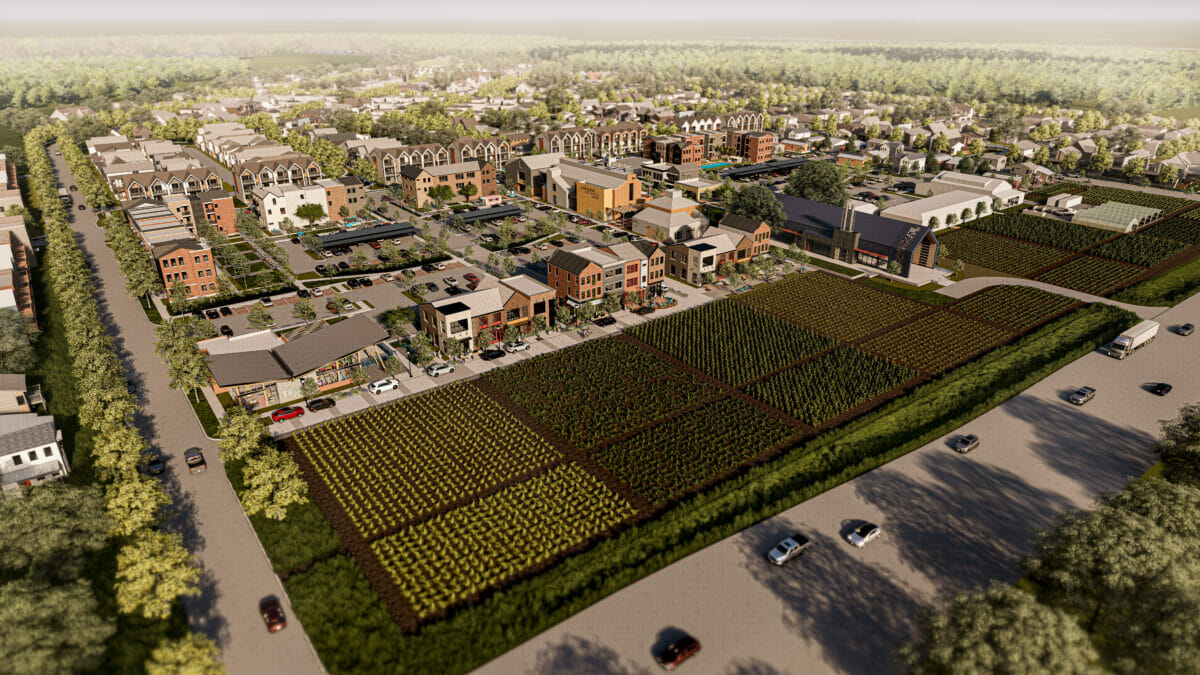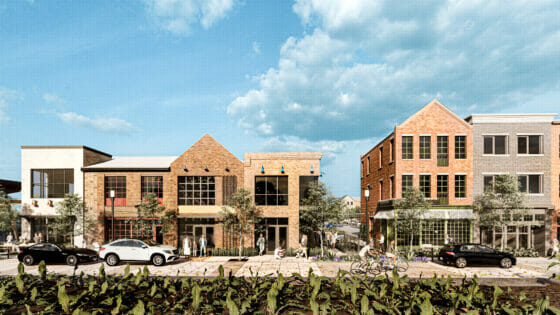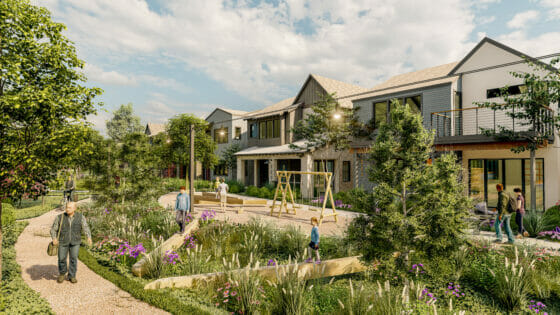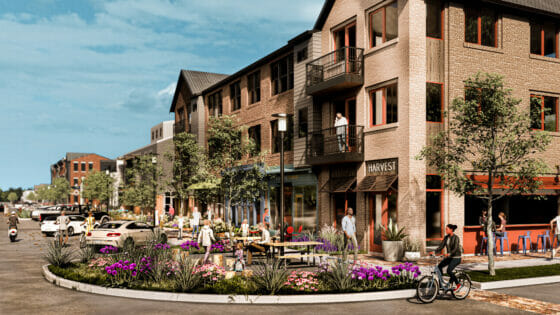Indigo, a new community outside of Houston, is a different type of residential development. Led by farmers, the project will be anchored by a 42-acre working farm.

When Scott Snodgrass and Clayton Garrett started their CSA in 2015, the Houston metro area wasn’t that familiar with the concept. They say their initial 350 CSA members roughly doubled the CSA membership in the area. With their 60 acres of vegetables, they became one of the biggest direct-to-consumer farms in the area—and they relished the opportunity to get more folks connected with their food and teach them about agriculture.

Render of Indigo Commons courtesy of CultivateLAND
The pair ran that farm for three years as Houston built up around them. Eventually, the outskirts of the city were encroaching on their farm, and the pair ran into bureaucratic issues. They wanted to renovate restrooms for the growing farm team, but they weren’t able to get the right building approvals. If they wanted to improve the road on their property, they were looking at hundreds of thousands of dollars; they weren’t making that even with the success of their CSA.
And then, Hurricane Harvey hit in 2017. While the nearby Brazos River didn’t flood, the guys lost everything. All of their crops. They took it as a sign to rethink their plans and how they were making use of the land. If developments were going up around them left and right, well, they could jump on that bandwagon, too. But they would do it as farmers first, part of the recent trend of farmers rethinking how best to use their land in the face of uncertain economic futures.
That’s when Indigo was born.
“We’re urbanists at heart, as well as the farmers,” says Snodgrass. With that in mind, Snodgrass and Garrett planned out a new community, using their existing land as a base. The goal is to have 750 residential homes, commercial and public areas, even a lake—all centered around a 42-acre working farm.

Render of Indigo Commons courtesy of CultivateLAND
After a few months of grading and readying the area, they broke ground at Indigo two weeks ago. This summer, the water and sewer lines will get installed, along with the critical infrastructure and paving. Then, in the fall, builders will start on the homes, with the grand opening currently scheduled for early 2024.
Throughout the building process, the pair says the goal is to weave nature and agriculture into the fabric of the neighborhood from the ground up. For example, the lake is also the drainage facility of the community. “We’re investing more than you would into a typical drainage facility, in order to make a wildlife habitat for birds and fish,” says Snodgrass. Investing in the natural benefits of the lake in turn “make it a more engaging amenity for residents who want to go there, for birdwatching, and they can fish in the lake, they can ride in a kayak, instead of it just being a typical retention pond.”
But it’s the 42-acre production farm that will anchor the community. Six acres will be devoted to vegetable production, with community plots and farmer’s markets. The other 36 acres will house livestock, both broiler chickens and hens, and traditional row crops, with some fun additions such as watermelon thrown in. If this sounds like a big undertaking, it is. But, for Garrett, it’s also exciting. “Farmers by nature are stubborn,” he says. “When we started our development journey, we were both stubborn. And we knew we were just going to have to do all of these things to accomplish our vision, to build the community that we’d be proud of.”

Render of Indigo Commons courtesy of CultivateLAND
While not everyone who lives in the community will necessarily be connected to the farm, residents will have access to the community garden plots and the vegetables produced onsite through a farmer’s market. Snodgrass and Garrett hope that many of the farm’s workers would also choose to live in the community and that people want to participate in community gardening projects.
That means, the guys say, that they want to make the units affordable within the growing Houston real-estate market and provide enough of a community and active neighborhood to entice people. They are looking at building vertically, committing to two- or three-story homes, rather than sprawling bungalows on huge lots. “Then you can condense everyone into a smaller space, and they can then walk to everything they need to get to. And we can reserve huge portions of the property for wildlife habitat and agriculture,” says Snodgrass. It’s a form of conservation development, where city planners start at the center (a main street or a community square) and build out from there, keeping in mind the facilities people will need as the neighborhood grows.
But when they initially tried to explain their vision to financial planners, there was resistance. “Our biggest challenge every step of the way was financial people and city managers saying ‘well, where has this been done before?’ We think we can be that new model,” says Snodgrass. “We’re farmers. We’re focused on the biodiversity within our habitats, interplanting, crop rotations and all those things that really [impact] how soil systems work. And we want to get our soil into healthy cycles. We take the same approach when we look at development, and I think it is shocking to some people.”
Still, Snodgrass says he and Garrett have worked hard to maintain their optimism and ethos throughout the project so far, and they will continue into the future. Instead, with this first agriculture-focused community as a model, they can tweak the formula and keep going. “Indigo will not be our last community.”
This is the kind of bold action needed now for so many urban centres. Cities are so vulnerable to economic shocks and food supply chain disruptions. They are not designed for resilience. Everything has to be shipped and trucked in from somewhere else with high cost for energy inputs. The more cities plan for local food growing and sourcing food from within a local radius, the more resilience is created. As we shift to a more decentralized supply chain model, we can learn to commit to meeting the needs of communities by the communities themselves. Great piece.
This is the most exciting ideal living situation for rural folks of all ages! What a great model this will be for other states to realize that this plan has appeal to a lot of us who do not want to return to the city for convenience sake. Good for these guys!
You use an acronym, CSA, without ever telling readers what it stands for.
This is wonderful!!! If I lived near Houston I would be there, helping! Wonder if there is any way of reaching out to these folks? Wonder if they have thought about tapping into Permaculturists, Woofers, or the Tiny House community where you might find like-minded thinkers. Bioregionalists might also provide good network. for helping the highly conservative Houston politicians with living examples. I believe there have been projects like this one in Cali and New Mexico.
Hats off to you all! Best news article I’ve read in weeks!!!
As someone who lives in the Houston area, I am super excited about this project. More and more of the Houston outskirts are being developed each year. All the green areas are being replaced with concrete and businesses we really don’t need. I love Houston but I’m tired of all the building. I will definitely be looking forward to how this project turns out.
There are other agriculture projects involving housing projects. It is an idea whose time has come. No more food desserts and future farmers here they develop with hands and imaginations in the soil. Of course, Regenerative, Permaculture, Organic absolutely no toxic chemical add ins